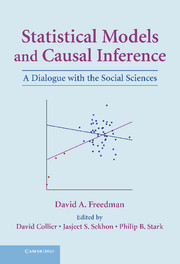Book contents
- Frontmatter
- Contents
- Preface
- Editors' Introduction: Inference and Shoe Leather
- Part I Statistical Modeling: Foundations and Limitations
- Part II Studies in Political Science, Public Policy, and Epidemiology
- 4 Methods for Census 2000 and Statistical Adjustments
- 5 On “Solutions” to the Ecological Inference Problem
- 6 Rejoinder to King
- 7 Black Ravens, White Shoes, and Case Selection: Inference with Categorical Variables
- 8 What is the Chance of an Earthquake?
- 9 Salt and Blood Pressure: Conventional Wisdom Reconsidered
- 10 The Swine Flu Vaccine and Guillain-Barré Syndrome: A Case Study in Relative Risk and Specific Causation
- 11 Survival Analysis: An Epidemiological Hazard?
- Part III New Developments: Progress or Regress?
- Part IV Shoe Leather Revisited
- References and Further Reading
- Index
4 - Methods for Census 2000 and Statistical Adjustments
Published online by Cambridge University Press: 05 June 2012
- Frontmatter
- Contents
- Preface
- Editors' Introduction: Inference and Shoe Leather
- Part I Statistical Modeling: Foundations and Limitations
- Part II Studies in Political Science, Public Policy, and Epidemiology
- 4 Methods for Census 2000 and Statistical Adjustments
- 5 On “Solutions” to the Ecological Inference Problem
- 6 Rejoinder to King
- 7 Black Ravens, White Shoes, and Case Selection: Inference with Categorical Variables
- 8 What is the Chance of an Earthquake?
- 9 Salt and Blood Pressure: Conventional Wisdom Reconsidered
- 10 The Swine Flu Vaccine and Guillain-Barré Syndrome: A Case Study in Relative Risk and Specific Causation
- 11 Survival Analysis: An Epidemiological Hazard?
- Part III New Developments: Progress or Regress?
- Part IV Shoe Leather Revisited
- References and Further Reading
- Index
Summary
Abstract. The U.S. Census is a sophisticated, complex undertaking, carried out on a vast scale. It is remarkably accurate. Statistical adjustment is unlikely to improve on the census, because adjustment can easily introduce more error than it takes out. The data suggest a strong geographical pattern to such errors even after controlling for demographic variables, which contradicts basic premises of adjustment. In fact, the complex demographic controls built into the adjustment process seem on whole to have been counter-productive.
Introduction
The census has been taken every ten years since 1790, and provides a wealth of demographic information for researchers and policy-makers. Beyond that, counts are used to apportion Congress and redistrict states. Moreover, census data are the basis for allocating federal tax money to cities and other local governments. For such purposes, the geographical distribution of the population matters more than counts for the nation as a whole. Data from 1990 and previous censuses suggested there would be a net undercount in 2000. Furthermore, the undercount would depend on age, race, ethnicity, gender, and–most importantly–geography. This differential undercount, with its implications for sharing power and money, attracted considerable attention in the media and the courthouse.
There were proposals to adjust the census by statistical methods, but this is advisable only if the adjustment gives a truer picture of the population and its geographical distribution.
Information
- Type
- Chapter
- Information
- Statistical Models and Causal InferenceA Dialogue with the Social Sciences, pp. 65 - 82Publisher: Cambridge University PressPrint publication year: 2009
